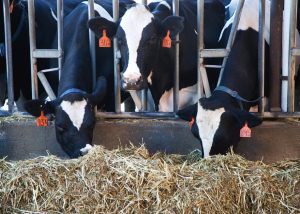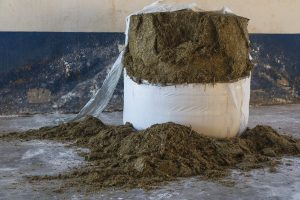Álvaro García
In a recent article (Forage Shortages, Low Milk Prices, and Practical Strategies for Dairy Producers), we discussed ways to increase opportunity milk, concluding that reducing mastitis and improving somatic cell counts (SCC) is the most cost-effective approach. Rigorous milk-quality protocols help dairy producers sustain productivity, particularly during periods of economic strain. Practices such as effective pre- and post-milking routines, consistent teat dipping, and timely mastitis treatment require minimal additional investment but deliver immediate financial benefits by reducing SCC and bacterial contamination. This improved milk quality directly enhances milk payments and overall production, providing dairy operations with quick profitability gains. To fully leverage this approach, producers must clearly understand the differences between environmental and contagious mastitis. Recognizing the distinct characteristics and transmission routes of these two mastitis types enables dairy producers to create management and prevention programs, maximizing milk quality, animal well-being, and profitability.
What is mastitis?
Mastitis is an inflammation of the mammary gland predominantly caused by bacterial infection. It remains a significant economic and animal welfare concern in dairy production, reducing milk yield and quality, and increasing treatment costs and culling rates. According to the USDA Animal and Plant Health Inspection Service (APHIS, 2016), approximately 24.8% of dairy cows in the U.S. experience clinical mastitis each year, making it one of the most prevalent health issues affecting dairy herds. The economic impact of mastitis in the U.S. dairy industry is substantial, estimated at nearly $2 billion annually due to losses in milk production, increased veterinary costs, discarded milk, and premature culling (APHIS, 2016; Ruegg, 2017).
Environmental mastitis
Environmental mastitis originates from bacteria commonly found in the cows’ surroundings, such as bedding, manure, soil, and water. These infections typically occur between milkings or during the dry period, emphasizing the importance of environment cleanliness.
Common pathogens:
- Escherichia coli (E. coli)
- Klebsiella pneumoniae
- Streptococcus uberis
- Streptococcus dysgalactiae
- Enterobacter spp.
Risk Factors: Dirty and wet bedding, overcrowding, poor ventilation, inadequate manure management, ineffective pre-milking teat preparation, and seasonal variations (particularly warm, humid conditions) increase mastitis risk.
Prevention strategies:
- Clean, dry bedding (preferably inorganic like sand)
- Regular stall cleaning
- Adequate ventilation and space per cow
- Proper pre-milking teat cleaning and drying
Treatment: Supportive care typically includes anti-inflammatory drugs like flunixin meglumine (1.1–2.2 mg/kg intravenously or intramuscularly every 24 hours, 36-hour milk withdrawal) or meloxicam (0.5 mg/kg subcutaneously once, 96-hour milk withdrawal). Severe cases may require intravenous fluid therapy (isotonic saline or lactated Ringer’s solution, typically no withdrawal required), and calcium supplementation as needed. Veterinary consultation ensures proper medication selection, dosage, and regulatory compliance.
Contagious mastitis
Contagious mastitis is transmitted primarily during milking through equipment or milkers’ hands, involving pathogens residing on udders or teat skin. These infections often become chronic, causing persistently high SCC.
Common pathogens:
- Staphylococcus aureus
- Streptococcus agalactiae
- Mycoplasma spp.
Risk Factors: Poor milking hygiene, lack of teat dipping, improperly sanitized milking equipment, and ineffective culling practices.
Prevention strategies:
- Rigorous milking hygiene
- Post-milking teat dipping with germicides
- Regular maintenance of milking equipment
- Routine screening and culling infected cows
Treatment: Streptococcus agalactiae infections typically respond to intramammary beta-lactam antibiotics such as penicillin or amoxicillin (administered once daily for 3–5 days, with milk withdrawal periods typically 72–96 hours). Staphylococcus aureus infections may require prolonged treatment with variable success; chronic cases often necessitate culling. Mycoplasma infections are resistant to antibiotics, and management typically involves identification and immediate culling of affected animals. Consult your veterinarian for tailored therapeutic approaches.
Economic benefits
Improving milk quality by reducing SCC offers significant economic benefits. A 50,000-cell/ml reduction in bulk-tank SCC can increase milk yield by 0.5–1.0 lb (0.23–0.45 kg) per cow daily. Dairy processors often provide quality premiums ranging from $0.10–$0.20 per hundredweight per 100,000-cell reduction. Reducing clinical mastitis cases, which typically cost $150–$250 each in treatments, discarded milk, and veterinary expenses, also significantly boosts profitability. For example, a dairy farm with 250 cows that reduces its bulk-tank SCC from 350,000 to 150,000 ml through improved stall cleanliness, effective teat dipping, and rigorous mastitis treatment protocols can expect an increased milk yield of approximately 1 lb. (almost 0.5 L.) /cow/day, earning an additional $0.30 per hundredweight premium and saving approximately $5,000 annually in treatment-related costs.
Effective mastitis management is crucial for dairy producers aiming to enhance profitability and animal welfare, especially during challenging economic times. By clearly distinguishing between environmental and contagious mastitis and implementing targeted management strategies—such as rigorous hygiene practices, careful environmental control, regular herd screening, and timely veterinary intervention—producers can significantly reduce SCC, enhance milk production, and lower operational costs. Investing proactively in mastitis prevention and management not only improves immediate financial outcomes but also ensures long-term sustainability, animal health, and competitive advantage within the dairy industry.
References
Keefe, G. (2012). Update on Control of Staphylococcus aureus and Streptococcus agalactiae for Management of Mastitis. Veterinary Clinics of North America: Food Animal Practice, 28(2), 203–216.
Ruegg, P. L. (2017). A 100-Year Review: Mastitis Detection, Management, and Prevention. Journal of Dairy Science, 100(12), 10381–10397.
Smith, K. L., & Hogan, J. S. (2017). Environmental Mastitis. Veterinary Clinics of North America: Food Animal Practice, 33(3), 507–523.
USDA-APHIS (2016). Dairy 2014: Milk Quality, Milking Procedures, and Mastitis on U.S. Dairies.
© 2025 Dellait Knowledge Center. All Rights Reserved.









